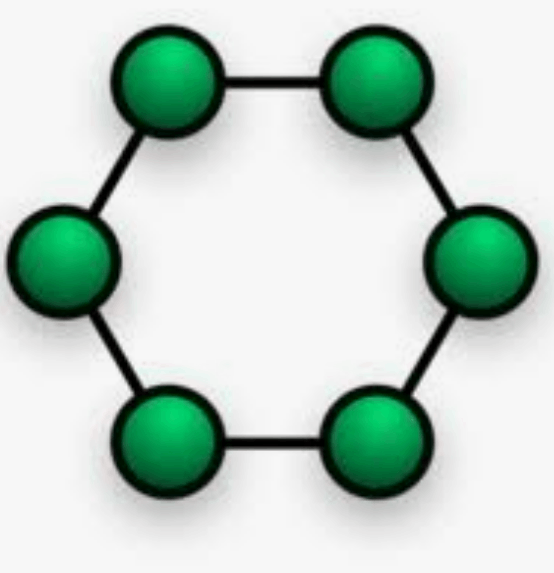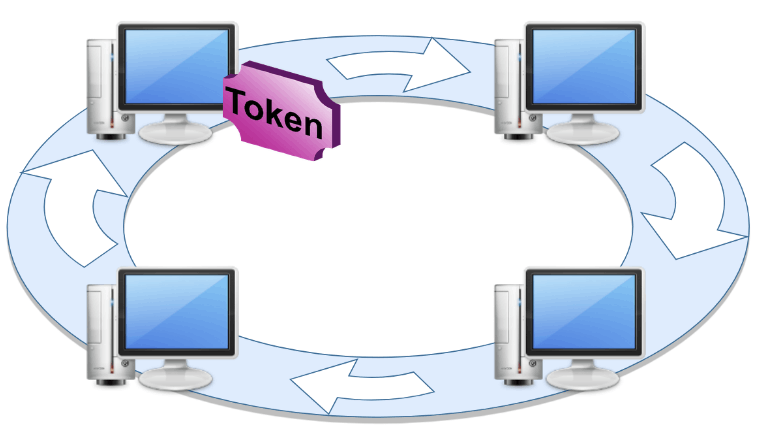What is a Ring Topology?
The word topology defines the relationship or arrangement of its component elements. A ring network is an architecture of a network where each node is connected to precisely two other nodes, creating a ring-shaped continuous signal channel across each node. From node to node, data is sent as each node processes a packet as it travels.
Rings can be in uni and bidirectional, with all traffic going in either of two directions. They are clockwise or anticlockwise.
Here is an alternate definition of ring topology:
A ring that transfers data typically only in one way is referred to as a unidirectional-directional ring. The data is transferred from one device to the next until it reaches its goal. Data can go in either way in a bidirectional ring.

Ring topology is more efficient as compared to bus topology because ring topology can handle heavier loads than a bus topology. Generally, there are two different kinds of ring topologies. They are bidirectional and unidirectional, respectively. Different types of ring topology installations function differently depending on the devices that are being connected to build a network. LANs or WANs may employ this structure.
Redundancy is offered via a variety of ring topologies, including:
Counter-rotating ring topology: In the opposite direction from the original ring, there is another ring. The backup ring is triggered in the event of a network switch failure, allowing data to continue to flow over the network.
Collapsed ring topology: The ring will "collapse" in the event of a failure, connecting every device to every other device and isolating the failed unit for simpler maintenance.

Working of Ring topology
The data transmission between various nodes in a ring topology includes the next step.
- At speeds ranging from 16 Mbps to 100 Mbps, the empty tokens on the ring are freely circulated.
- The sender's or receiver's address can be held in these tokens’ placeholders and data frames for storing.
- The data, MAC address of the receiving node, and the transmitting node's ID are all packed into the token's equivalent spaces when a transmitting node wants to send a message.
- To the subsequent ring node, this filled token is sent. Next, the token is received by the subsequent node, which then sets the token to zero and sends it to the subsequent node after verifying whether the data being transferred is copied from the frame toward the node. The token is then reset to zero and forwarded to the next node, or whether the token is just sent to the next node as is.
- The preceding procedure is repeated until the data reaches its intended location.
- The message will be separated after the token reaches the sender and determines that the recipient has read the contents.
- The token has been used previously and is available by any network node.
Data is transferred backward toward the destination if a node is stationary within the ring network's path, the connection breaks down, and the network only supports a dual ring.
Why we choose ring topology?
The following are some criteria to consider while choosing the network topology:
- This kind of network enables speedier data transmission.
- This topology is less expensive and affordable than others.
- The organizational structure
- The difficulty of the environment.
- Any new nodes may be added to a ring topology network without trouble.
- Budgetary allotment.
Access procedures
Circuits, packets, or a combination of both can be carried by rings. Loops are carried by SDH rings. Out-of-band signalling methods are used to set up circuits, whereas the Medium Access Control Protocol is often used to carry packets (MAC).
Media access control is used to regulate which station broadcasts when. The objectives are to ensure fairness and resolve conflict, as with any MAC protocol. For ring networks, there are three primary kinds of media access protocol: slotted, token, and register insertion.
The slotted ring views the ring network's latency as a large shift register those spins continuously. It is structured into supposedly fixed-size slots. Control flags in the slot's head indicate whether a slot is full or empty. When a slot becomes available, a station that wants to broadcast inserts data into it. The slot may be released by other stations copying the data, or it may return to the source that released it. If the sender is prohibited from immediately reusing it, one benefit of source-release is that all other stations get the opportunity to utilize it first, preventing bandwidth hoarding. The Cambridge Ring is the best illustration of a slotted ring.
Advantages of using ring topology
- Very well-organized network with token access and transmission opportunities for every device. There are no network collisions since data only travels one way over the network.
- On the bandwidth, adding more nodes has relatively little effect.
- A packet collision is less likely since data only goes in one way.
- Controlling network connectivity does not need a network server.
- The performance of the network won't be impacted by adding more devices.
- Single sites of failure are simple to locate and isolate.
- superior to a bus topology in areas with significant traffic.
Disadvantages of using ring topology
- The ring is broken, and data cannot be sent if any nodes malfunction.
- An intricate ring network architecture is challenging to diagnose.
- Wires connect all nodes; therefore, adding more nodes requires momentarily stopping the network.
- The whole network will be affected if one device fails.
- Ring topology is more expensive than a bus topology for implication.
LANs and WANs may employ this ring topology structure. This is the main application of ring topology.